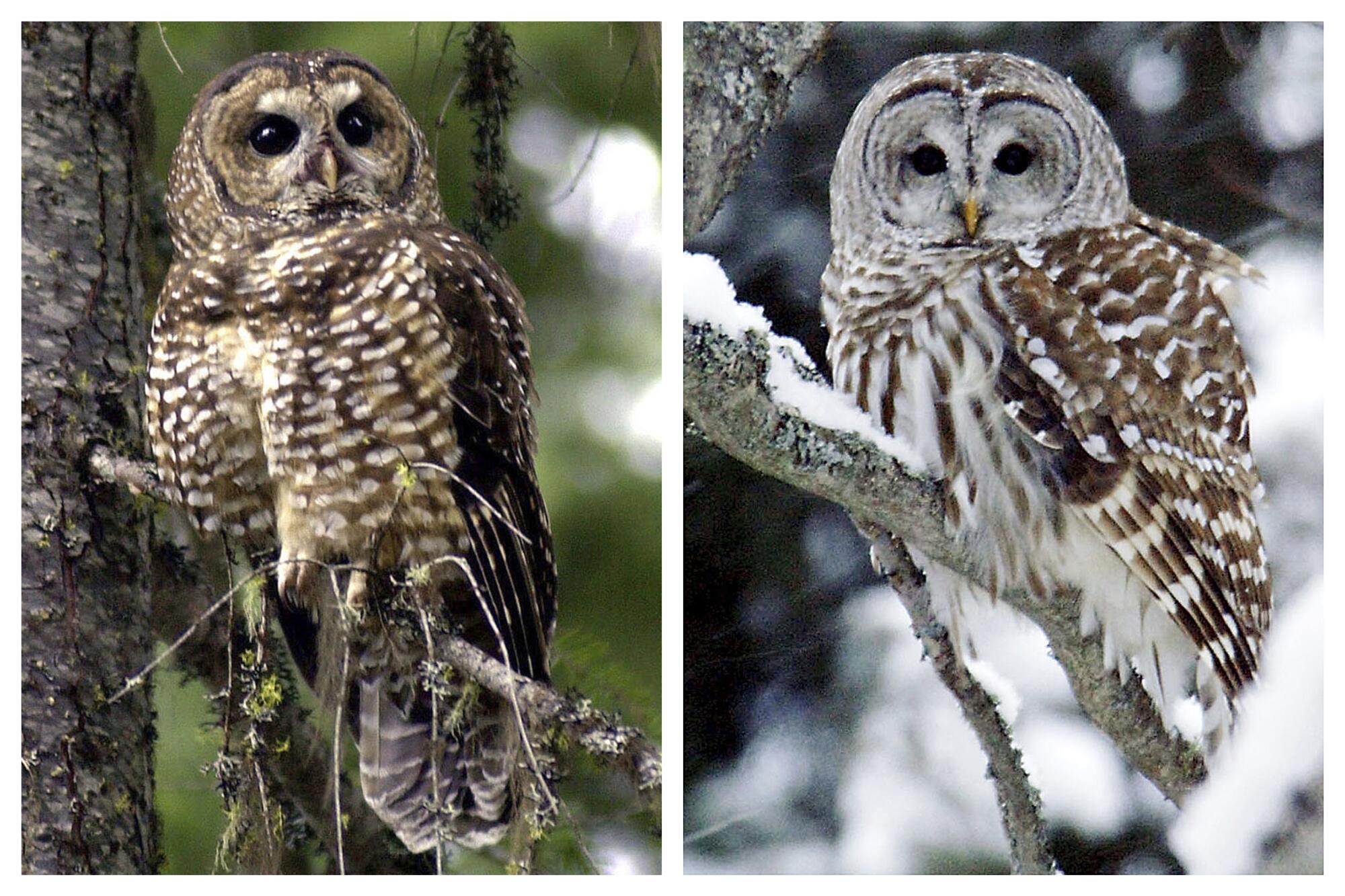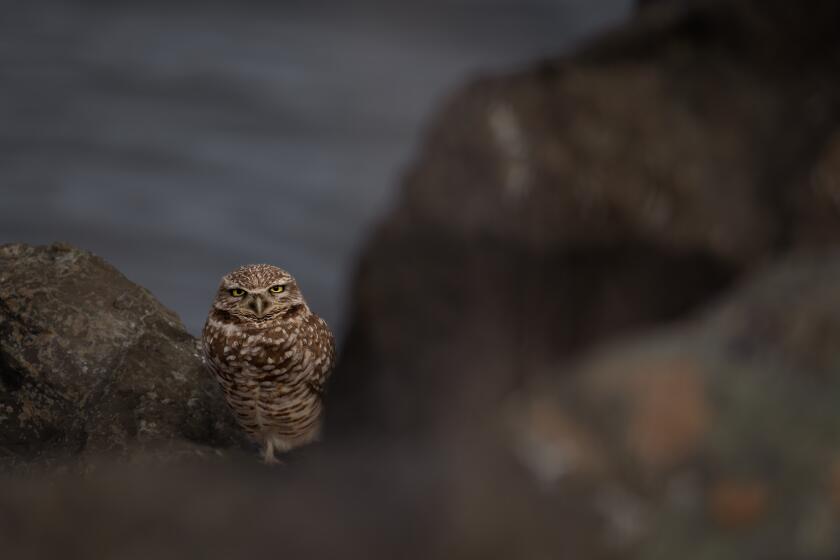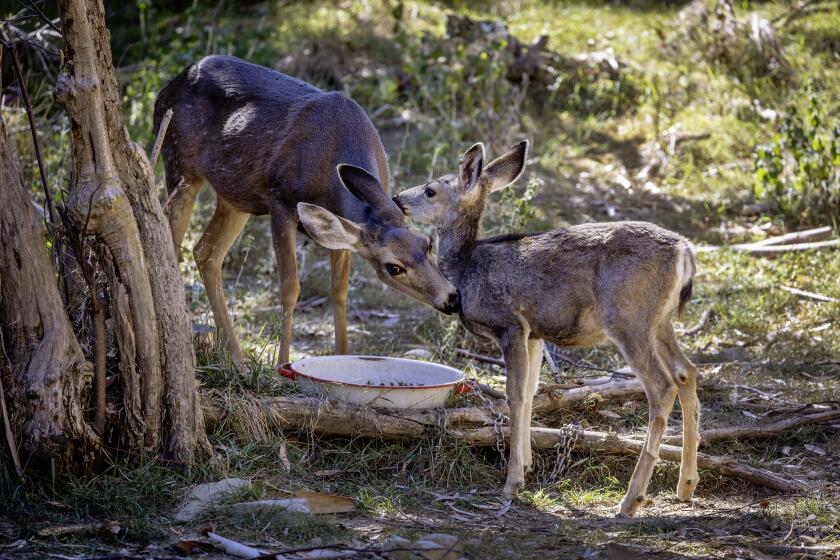
- Share via
A federal government plan for hunters to kill thousands of invasive owls to protect the rapidly declining northern spotted owl has ruffled the feathers of dozens of animal advocacy groups.
On Monday, a coalition of 75 animal rights and wildlife protection organizations sent a letter to U.S. Interior Secretary Deb Haaland asking her to scrap what they describe as a “reckless plan” to wipe out half a million barred owls in West Coast states over the next three decades.
The letter, spearheaded by the Animal Wellness Action group and the Center for a Humane Economy, lambastes the plan for being unworkable and short-sighted, arguing that it will lead to the wrong owls being shot and disruption to nesting behavior.
“Implementing a decades-long plan to unleash untold numbers of ‘hunters’ in sensitive forest ecosystems is a case of single-species myopia regarding wildlife control,” states the letter, signed by Wayne Pacelle, president of Animal Wellness Action, and Scott Edwards, general counsel for the Center for a Humane Economy.
Federal wildlife officials believe the action is necessary to control the population of the barred owl — which they consider invasive — and give the threatened northern spotted owls a fighting chance on their home turf.
The proposal is also intended to prevent declines of the California spotted owl, which wildlife officials say is also facing encroachment from the larger, more aggressive barred owl in the Sierra Nevada.
“Extirpation of northern spotted owls from major portions of their historical range is likely in the near future without management of barred owls,” the U.S. Fish and Wildlife Service wrote in its proposal, citing a recent demographic analysis.
Advocates say the decline of the burrowing owl in California has accelerated. They want the state to add the bird to the endangered or threatened list.
Barred owls and northern spotted owls are closely related and can even interbreed. But the barred owls, which originally hailed from the eastern U.S., have been described as its relative’s “nemesis.”
The barred owl is more of a generalist, eating a wider array of food and occupying a broader habitat.
The northern spotted owl is pickier — and smaller. Its range stretches from northwestern California to southwestern British Columbia, including western Oregon and Washington, according to the National Wildlife Foundation.
Smithsonian Magazine reports that spotted owl numbers have plummeted by about 75% over the last two decades, citing the U.S. Fish and Wildlife Service, while barred owls appear to be thriving.
In 1990, northern spotted owls were listed as threatened under the federal Endangered Species Act in 1990. They were listed as threatened under the California Endangered Species Act in 2016.
There’s broad agreement the native owls are at risk, but the animal rights organizations behind the opposition letter this week say killing barred owls is not the answer. Instead, the groups advocate for nonlethal means to protect the spotted owls, including safeguarding their habitat.
“The plan to kill barred owls is a colossally reckless action ... it should be sidelined with all deliberate speed, and non-lethal management actions to protect spotted owls and their habitats should be made the priority actions.”
Not all wildlife protection groups agree, however.
Tom Wheeler, executive director of the Environmental Protection Information Center, called the letter criticizing the proposal to beat back barred owls “factually misleading” and “divorced from what’s actually being proposed.”
The letter reports that there will be “mistaken-identity kills,” potentially of the spotted owls they seek to protect, but Wheeler said the proposal outlines a strategy to avoid this.
Those opposing the plan also decry lead poisoning that could result from the shot used by hunters. According to Wheeler, the plan calls for the owl carcasses to be removed from the area where they’re shot. California has banned hunting with lead ammunition.
The proposal — which remains a draft — would not result in the immediate slaughter of barred owls.
Instead, it would remove the permitting burden for others to remove the birds, Wheeler said.
Public land managers, such as the federal Fish and Wildlife Service and Forest Service, as well as private landowners, “will be able to more expeditiously engage in this activity,” he said.
Wheeler said he recognized the issue was morally fraught, but doesn’t feel there’s an alternative. If nothing is done to control the barred owls, he believes the northern spotted owl will go extinct in his lifetime.
His organization wants federal wildlife officials to take even more aggressive steps to stop the forward march of the invasive owls.
“We have a functional choice, which is the extinction of one species, or we could have both species continue to exist on the landscape,” he said.
Catalina Island Conservancy and residents near compromise over deer eradication proposal









